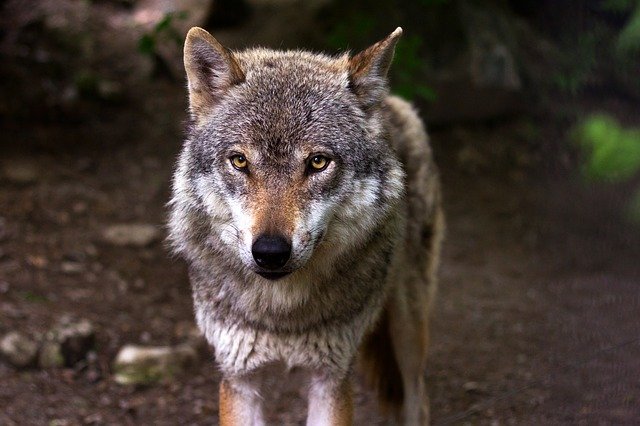Is it really true that wolves eat coyotes? Yes they do! But let’s understand why and when…
Coyotes are not a typical part of the wolf’s diet, but if starving, threatened, or victimized, the wolf will not hesitate to kill or even eat a coyote.
But why isn’t the coyote a natural part of the wolf’s diet?
It comes down to:
- They are related;
- Food preference;
- Practicality;
- Energy spent vs. food gained.
Are Wolves And Coyotes Related?
Yes, they are related. Look into their correct names… Canis lupus (Wolves) and Canis latrans (Coyotes).
They can actually interbreed and give birth to a mixed breed called coywolves.
In fact, coyotes are considered by many to a vey close (if not the closest) ancestor to Wolves.
Wolves Eating Coyotes – Food Preference
Like most animals, the wolf has a preferred food source – ungulates or hooved animals.
Ungulates have a lot of flesh and good fat stores – they make prime targets for wolves because of how calorie-rich they are.
In stark contrast to ungulates, the coyote has a slim frame, high muscle, and little fat.
Having such little meat and fat on their body makes coyote meat tough and much less favorable.
Coyotes usually eat rabbits, fruits, birds, flowers, and snakes, but the wolf prefers large, hoofed mammals.
Wolves eat coyotes, yes, but only under specific situations.
The Overlapping Territory Effect
Wolves and coyotes have a unique relationship, with wolves taking on the apex predator role and coyotes adjusting their behavior to coexist.
This behavioral change in coyotes happens most often when humans reintroduce wolves to areas as part of a species conservation effort and when seasonal changes make food scarcer.
Curiosity: Can Wolves Climb Trees?
As the two species begin to share more territory, they must either compete for the same food sources, target each other as prey, or adjust their diet and behavior to coexist.
The apex predator in the coyote-wolf power couple is the wolf; however, a coyote still benefits the most from having such a close neighbor.
When sharing territory with the wolf, the coyote also incorporates hoofed mammals as a mainstay of their diet.
The coyote’s behavioral change is simply because:
– Coyotes are scavengers, and with wolves to kill for them, the coyotes have access to more ungulate carcasses. Keep in mind that wolves consume at least 90% of their kills, so there is not too much left!
– As wolves chase prey, they drive herds into coyote territory giving coyotes more opportunities to get a fresh meal.
Curiosity: Can Dogs and Wolves Breed? — Unraveling the Mystery.
What does the wolf get out of this environment, though?
The truth is – very little.
Wolves are exceptionally territorial animals and do not tolerate scavengers coming to their territory and stealing food or competing for limited resources.
So, for the wolf, the coyote is an inconvenience.
There is, however, one benefit of having coyotes close by – when food is scarce, and the wolf pack is starving, coyotes offer the option of a quick meal (yup, wolves eat coyotes, there you go).
Why Doesn’t The Wolf Eat More Coyote?
Coyote meat poses an additional challenge for the wolfpack, too – coyotes travel and hunt alone or in loose pairs despite living in groups/families.
However, wolves live, travel, and pursue strategically as a wolfpack, with the average pack of between six and ten individuals.
So to hunt a single coyote or a group of two coyotes, the full wolfpack must assemble to hunt.
And, with as little meat as the coyote offers, the wolf pack would have to bring down close to one coyote for each adult wolf in the wolf pack, and feeding each pack member would mean tracking and killing multiple coyotes.
The amount of hunting it would take to find enough coyote meat to feed a pack of wolves would expend far too much energy for extraordinarily little return.
Will A Wolf Befriend the Coyote?
If the wolf will not eat a coyote, would it ever befriend it?
There are certainly some unlikely friendships between different animal species, but most of these friendships occur between animals only after human interference.
For the most part, though, the coyote is nothing but competition for the wolf.
If a wolfpack hears, sees, or smells a coyote in their territory, they will chase them out of the area. The coyote, outnumbered by the pack, will turn tail and run.
If the coyote is resistant, the wolfpack will display dominance to chase it away.
If a display of dominance does not work, and the coyote stands their ground, the wolfpack will attack, and if the coyote does not escape, the wolf pack will hunt and kill it.
Even though coyote meat is not preferable, the wolfpack will not let it go to waste, and wolves will eat the coyote body.
Conclusion / Summary
Wolf and coyote territory often border, meaning carnivores compete for the same resources.
While the more dominant of the two species is the wolf, a wolfpack is more likely to chase away the coyote than kill and eat it.
Although the wolf is not prone to eating coyote meat, it will if the opportunity arises.
For example, a starving wolf will eat coyote meat before it allows itself to die from starvation, and the body of a coyote killed by the pack for crossing into pack territory will rarely go to waste.



